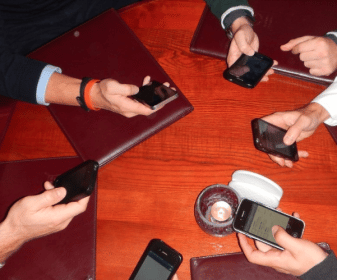You wouldn’t know that if you swallowed The New York Times publicity for Sherry Turkle’s latest book, Reclaiming Conversation, which apparently argues that smartphones are alienating everyone from everyone else. A front cover essay in the September 26 NYT Sunday Review by Professor Turkle combined with a forthcoming rave review of the new book by novelist Jonathan Franzen–huh, a novelist? when there are many expert researchers who could have reviewed?—and a 2012 preview by Turkle as well as a 2013 one—leave quite an impression that smartphones have silenced Americans.
Deja vu all over again (requiescat in pace, Yogi Berra).
In 2011, Times reviewer Michiko Kakatuni gave Turkle’s previous book, Alone Together: Why We Expect More From Technology and Less From Each Other, a strong thumbs-up and science journalist Jonah Lehrer (later discredited) wrote the Sunday book review, albeit with some criticisms. One should also note that Professor Turkle has long been the go-to source on the social consequences of digital communications for the Times.
All this coverage despite researchers’ skepticism, based on systematic evidence, about the claim that digital technology is alienating Americans. (My earlier comments are here and here.) Indeed, the Times itself published a piece last year in the Magazine entitled, “Technology Is Not Driving Us Apart After All,” reviewing some of the science. I guess someone at the paper did not get the memo.
So, what am I complaining about now?
(Disclosure: I have not read Professor Turkle’s new book, only her Sunday Review essay.)
The thesis she posits: People are not having human conversations with one another anymore because they are escaping into their virtual communications. Now, almost everybody—including me—is grumpy about people eyeing their smartphones rather than the person in front of them. And there may well be something to this assertion. But we want some systematic, reliable evidence that Americans converse less in person than before, attend to one another less, and suffer more as a consequence. It is hard to find such evidence.
Much of the “data” in Turkle’s essay (and I presume the new book) is anecdotal. As in Alone Together, the documentation is mainly people here and there, especially unhappy people, with whom she talks. These reports may all be totally truthful and still the thesis be wrong. Fifty years ago, Turkle might have well have heard similar grousing about people eating together silently, or burying their noses in the newspaper, or, heaven knows, turning away to watch the always-on TV set.
In addition, Turkle cherry picks studies. For example, early in her essay, she cites a Pew survey this way: “In a 2015 study by the Pew Research Center, 89 percent of cellphone owners said they had used their phones during the last social gathering they attended. But they weren’t happy about it; 82 percent of adults felt that the way they used their phones in social settings hurt the conversation.” Here is how the Pew researchers summarized their 2014 findings (published 2015) about phones and social gatherings:
When asked about some specific ways they might have used their cellphone during their most recent social gathering . . . . a share [of respondents] are trying to avoid or disengage from the people they are physically present with: 16% used their phone because they are no longer interested in what the group was doing; 15% wanted to connect with other people who are strangers to the group; and 10% used their phone to avoid participating in what the group was discussing.
However, it was more often the case that people used their cellphone in a manner tied to the gathering: 45% used their phone to post a picture or video they had taken of the gathering; 41% used their phone to share something that had occurred in the group by text, email or social networking site; 38% used their phone to get information they thought would be interesting to the group; 31% used their phone to connect with other people who are known to the group.
In all, 78% cited at least one of these four “group-contributing” reasons, compared with 30% who used their phone for one of the three “retreating-from-the-group” reasons.
When using their cellphones in public spaces, most users do so for information gathering and social purposes, rather than explicitly anti-social purposes.
And compare the Pew authors’ summary to Turkle’s summary (above) about people’s feelings in such cases. The Pew report: “82% of all adults (not just cell owners) say that when people use their cellphones at social gatherings, it at least occasionally hurts the conversation and atmosphere of the gathering” (not, as Turkle wrote, that “the way they [themselves] used their phones in social settings [generally] hurt the conversation”). Moreover, among those who did use their phones, the Pew report states, “75% said their phone use took none (32%) or only “a little” (43%) of their attention away from the group. . .”
Turkle could say these folks were fooling themselves about their phone use, that it really was distracting. Maybe. But you cannot draw on the survey for one (inaccurate) point and ignore the rest.
Another example of cherry picking: Turkle reports on a psychological study finding a 40 percent decline in college students’ levels of empathy, “with most of the decline taking place after 2000.” Must be because of smartphones, concludes Turkle. (Actually, the average score dropped 0.65 standard deviations and about half of the decline was between 1990 and 2000—see here, pp. 6–7, but never mind.) Yet, Turkle does not discuss, at least not in her essay, a number of studies showing no declines during the smartphone era in Americans’ levels of social ties nor any increases in their reported loneliness; and she does not discuss the studies showing, if any association, a positive one between online activity and in-person relationships (see, e.g., here and here, as well as the Times Magazine story noted earlier).
To be sure, the ubiquity of smartphones must be making a difference in Americans’ personal relations, as their use is making a difference in, for example, how farmers and fishermen in the global South are handling their businesses. But that social difference is likely to be a complex mix of new habits—many only now jelling (see this recent post)—and a complex mix of the good, the bad, and the just different. We need to focus on close, systematic, and comparative study of what is changing—and then inform the public.
Turkle’s suggestions for how Americans could foster richer conversations—teach children to attend to dinner-table talk, put distracting devices in another room, etc.—seem worthwhile (and would have been worthwhile in the 1950s, too). But, even wise counsel can get lost under the scary and misleading headlines.
I guess the Times editors have their meme and they will ride it hard.
Update, October 1, 2015:
Courtesy of Keith Hampton: “‘What a strange practice it is. . .that a man should sit down to his breakfast table and, instead of conversing with his wife, and children, hold before his face a sort of screen on which is inscribed a world-wide gossip.’ [Sociology founding father] Charles Cooley (1909) on the death of conversation as a result of that evil new technology/practice—the morning delivery of the newspaper.”








